Primary Health Care: Social Determinants and Project Analysis
VerifiedAdded on 2022/12/05
|6
|1991
|21
Report
AI Summary
This report examines the social determinants of health within the framework of primary health care, focusing on the 'It Takes a Village' project. It explores key determinants such as access to healthcare and individual economic standards, highlighting their impact on health outcomes, especially for vulnerable populations like Aboriginal Torres Islanders and teenage mothers. The report discusses the principles of primary health care, emphasizing illness prevention and health promotion strategies aligned with the Ottawa Charter, including the 'enable' strategy. Furthermore, it underscores the significance of cultural competence in healthcare delivery, emphasizing its role in improving patient outcomes and satisfaction. The analysis concludes by emphasizing the project's contribution to addressing maternal issues and fostering a healthy environment for children within the community, demonstrating the interconnectedness of social determinants and effective healthcare initiatives.

Running head: PRIMARY HEALTH CARE
Name of the Student
Name of the University
Author Note
Name of the Student
Name of the University
Author Note
Paraphrase This Document
Need a fresh take? Get an instant paraphrase of this document with our AI Paraphraser
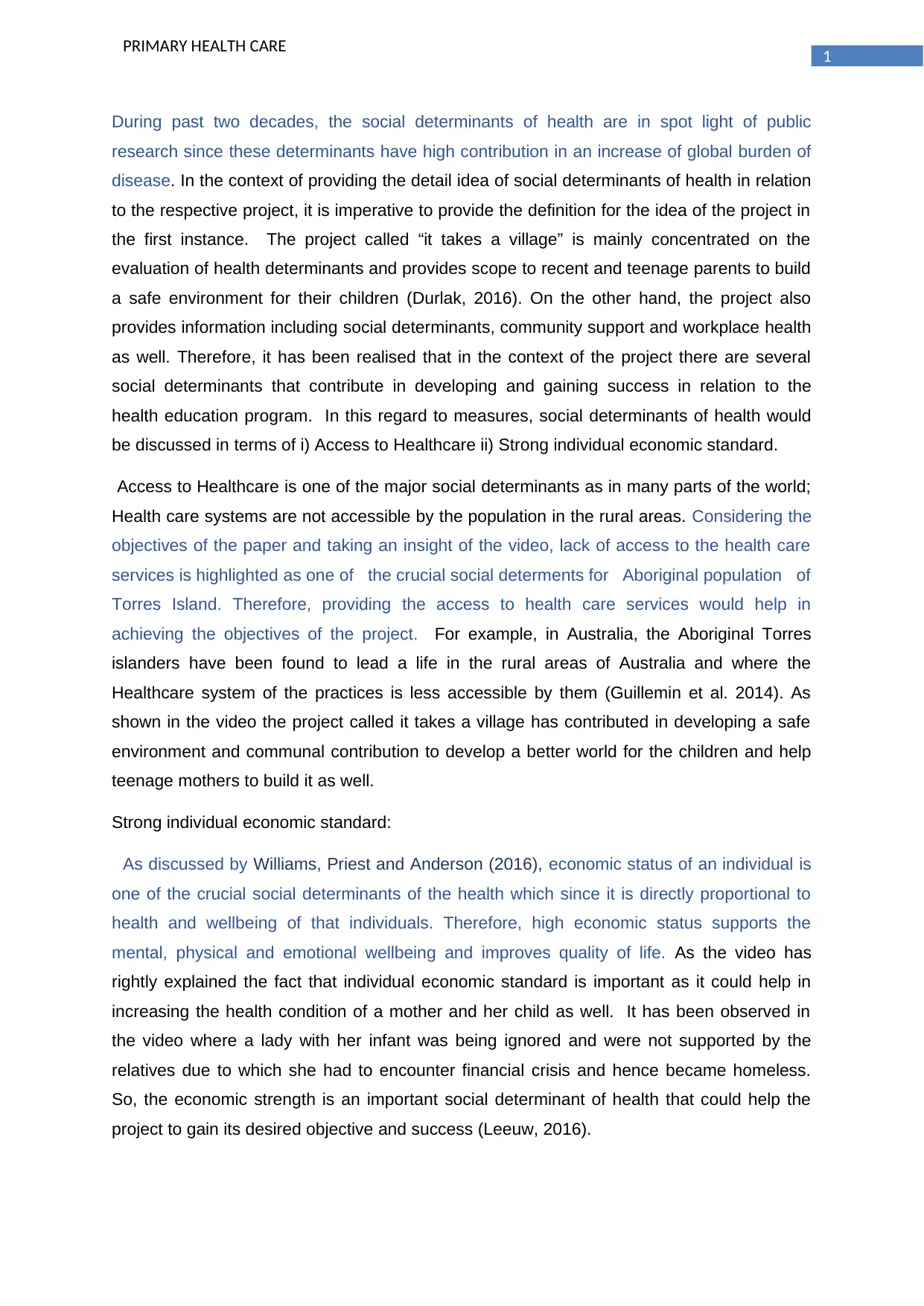
1
PRIMARY HEALTH CARE
During past two decades, the social determinants of health are in spot light of public
research since these determinants have high contribution in an increase of global burden of
disease. In the context of providing the detail idea of social determinants of health in relation
to the respective project, it is imperative to provide the definition for the idea of the project in
the first instance. The project called “it takes a village” is mainly concentrated on the
evaluation of health determinants and provides scope to recent and teenage parents to build
a safe environment for their children (Durlak, 2016). On the other hand, the project also
provides information including social determinants, community support and workplace health
as well. Therefore, it has been realised that in the context of the project there are several
social determinants that contribute in developing and gaining success in relation to the
health education program. In this regard to measures, social determinants of health would
be discussed in terms of i) Access to Healthcare ii) Strong individual economic standard.
Access to Healthcare is one of the major social determinants as in many parts of the world;
Health care systems are not accessible by the population in the rural areas. Considering the
objectives of the paper and taking an insight of the video, lack of access to the health care
services is highlighted as one of the crucial social determents for Aboriginal population of
Torres Island. Therefore, providing the access to health care services would help in
achieving the objectives of the project. For example, in Australia, the Aboriginal Torres
islanders have been found to lead a life in the rural areas of Australia and where the
Healthcare system of the practices is less accessible by them (Guillemin et al. 2014). As
shown in the video the project called it takes a village has contributed in developing a safe
environment and communal contribution to develop a better world for the children and help
teenage mothers to build it as well.
Strong individual economic standard:
As discussed by Williams, Priest and Anderson (2016), economic status of an individual is
one of the crucial social determinants of the health which since it is directly proportional to
health and wellbeing of that individuals. Therefore, high economic status supports the
mental, physical and emotional wellbeing and improves quality of life. As the video has
rightly explained the fact that individual economic standard is important as it could help in
increasing the health condition of a mother and her child as well. It has been observed in
the video where a lady with her infant was being ignored and were not supported by the
relatives due to which she had to encounter financial crisis and hence became homeless.
So, the economic strength is an important social determinant of health that could help the
project to gain its desired objective and success (Leeuw, 2016).
PRIMARY HEALTH CARE
During past two decades, the social determinants of health are in spot light of public
research since these determinants have high contribution in an increase of global burden of
disease. In the context of providing the detail idea of social determinants of health in relation
to the respective project, it is imperative to provide the definition for the idea of the project in
the first instance. The project called “it takes a village” is mainly concentrated on the
evaluation of health determinants and provides scope to recent and teenage parents to build
a safe environment for their children (Durlak, 2016). On the other hand, the project also
provides information including social determinants, community support and workplace health
as well. Therefore, it has been realised that in the context of the project there are several
social determinants that contribute in developing and gaining success in relation to the
health education program. In this regard to measures, social determinants of health would
be discussed in terms of i) Access to Healthcare ii) Strong individual economic standard.
Access to Healthcare is one of the major social determinants as in many parts of the world;
Health care systems are not accessible by the population in the rural areas. Considering the
objectives of the paper and taking an insight of the video, lack of access to the health care
services is highlighted as one of the crucial social determents for Aboriginal population of
Torres Island. Therefore, providing the access to health care services would help in
achieving the objectives of the project. For example, in Australia, the Aboriginal Torres
islanders have been found to lead a life in the rural areas of Australia and where the
Healthcare system of the practices is less accessible by them (Guillemin et al. 2014). As
shown in the video the project called it takes a village has contributed in developing a safe
environment and communal contribution to develop a better world for the children and help
teenage mothers to build it as well.
Strong individual economic standard:
As discussed by Williams, Priest and Anderson (2016), economic status of an individual is
one of the crucial social determinants of the health which since it is directly proportional to
health and wellbeing of that individuals. Therefore, high economic status supports the
mental, physical and emotional wellbeing and improves quality of life. As the video has
rightly explained the fact that individual economic standard is important as it could help in
increasing the health condition of a mother and her child as well. It has been observed in
the video where a lady with her infant was being ignored and were not supported by the
relatives due to which she had to encounter financial crisis and hence became homeless.
So, the economic strength is an important social determinant of health that could help the
project to gain its desired objective and success (Leeuw, 2016).
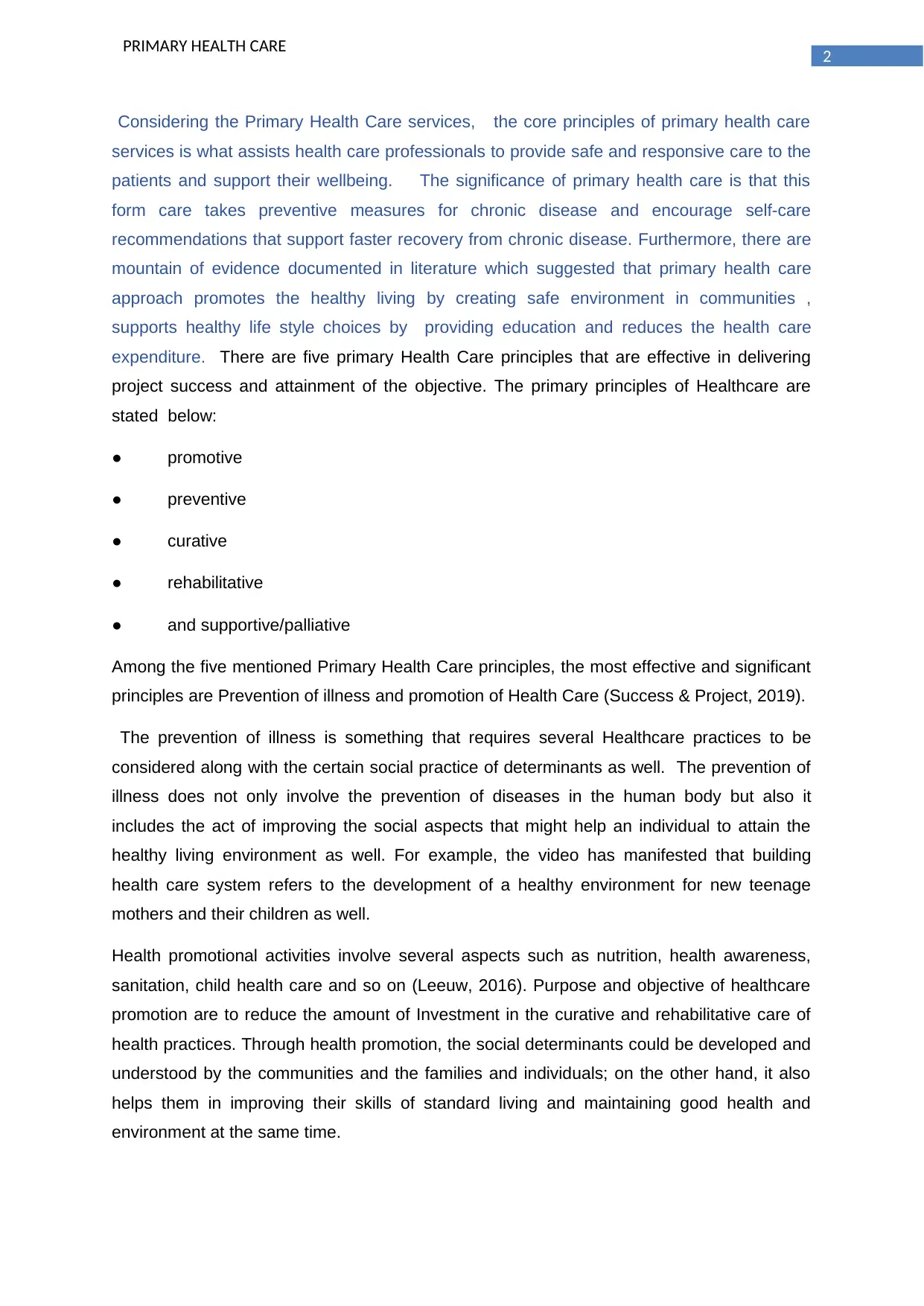
2
PRIMARY HEALTH CARE
Considering the Primary Health Care services, the core principles of primary health care
services is what assists health care professionals to provide safe and responsive care to the
patients and support their wellbeing. The significance of primary health care is that this
form care takes preventive measures for chronic disease and encourage self-care
recommendations that support faster recovery from chronic disease. Furthermore, there are
mountain of evidence documented in literature which suggested that primary health care
approach promotes the healthy living by creating safe environment in communities ,
supports healthy life style choices by providing education and reduces the health care
expenditure. There are five primary Health Care principles that are effective in delivering
project success and attainment of the objective. The primary principles of Healthcare are
stated below:
● promotive
● preventive
● curative
● rehabilitative
● and supportive/palliative
Among the five mentioned Primary Health Care principles, the most effective and significant
principles are Prevention of illness and promotion of Health Care (Success & Project, 2019).
The prevention of illness is something that requires several Healthcare practices to be
considered along with the certain social practice of determinants as well. The prevention of
illness does not only involve the prevention of diseases in the human body but also it
includes the act of improving the social aspects that might help an individual to attain the
healthy living environment as well. For example, the video has manifested that building
health care system refers to the development of a healthy environment for new teenage
mothers and their children as well.
Health promotional activities involve several aspects such as nutrition, health awareness,
sanitation, child health care and so on (Leeuw, 2016). Purpose and objective of healthcare
promotion are to reduce the amount of Investment in the curative and rehabilitative care of
health practices. Through health promotion, the social determinants could be developed and
understood by the communities and the families and individuals; on the other hand, it also
helps them in improving their skills of standard living and maintaining good health and
environment at the same time.
PRIMARY HEALTH CARE
Considering the Primary Health Care services, the core principles of primary health care
services is what assists health care professionals to provide safe and responsive care to the
patients and support their wellbeing. The significance of primary health care is that this
form care takes preventive measures for chronic disease and encourage self-care
recommendations that support faster recovery from chronic disease. Furthermore, there are
mountain of evidence documented in literature which suggested that primary health care
approach promotes the healthy living by creating safe environment in communities ,
supports healthy life style choices by providing education and reduces the health care
expenditure. There are five primary Health Care principles that are effective in delivering
project success and attainment of the objective. The primary principles of Healthcare are
stated below:
● promotive
● preventive
● curative
● rehabilitative
● and supportive/palliative
Among the five mentioned Primary Health Care principles, the most effective and significant
principles are Prevention of illness and promotion of Health Care (Success & Project, 2019).
The prevention of illness is something that requires several Healthcare practices to be
considered along with the certain social practice of determinants as well. The prevention of
illness does not only involve the prevention of diseases in the human body but also it
includes the act of improving the social aspects that might help an individual to attain the
healthy living environment as well. For example, the video has manifested that building
health care system refers to the development of a healthy environment for new teenage
mothers and their children as well.
Health promotional activities involve several aspects such as nutrition, health awareness,
sanitation, child health care and so on (Leeuw, 2016). Purpose and objective of healthcare
promotion are to reduce the amount of Investment in the curative and rehabilitative care of
health practices. Through health promotion, the social determinants could be developed and
understood by the communities and the families and individuals; on the other hand, it also
helps them in improving their skills of standard living and maintaining good health and
environment at the same time.
⊘ This is a preview!⊘
Do you want full access?
Subscribe today to unlock all pages.

Trusted by 1+ million students worldwide
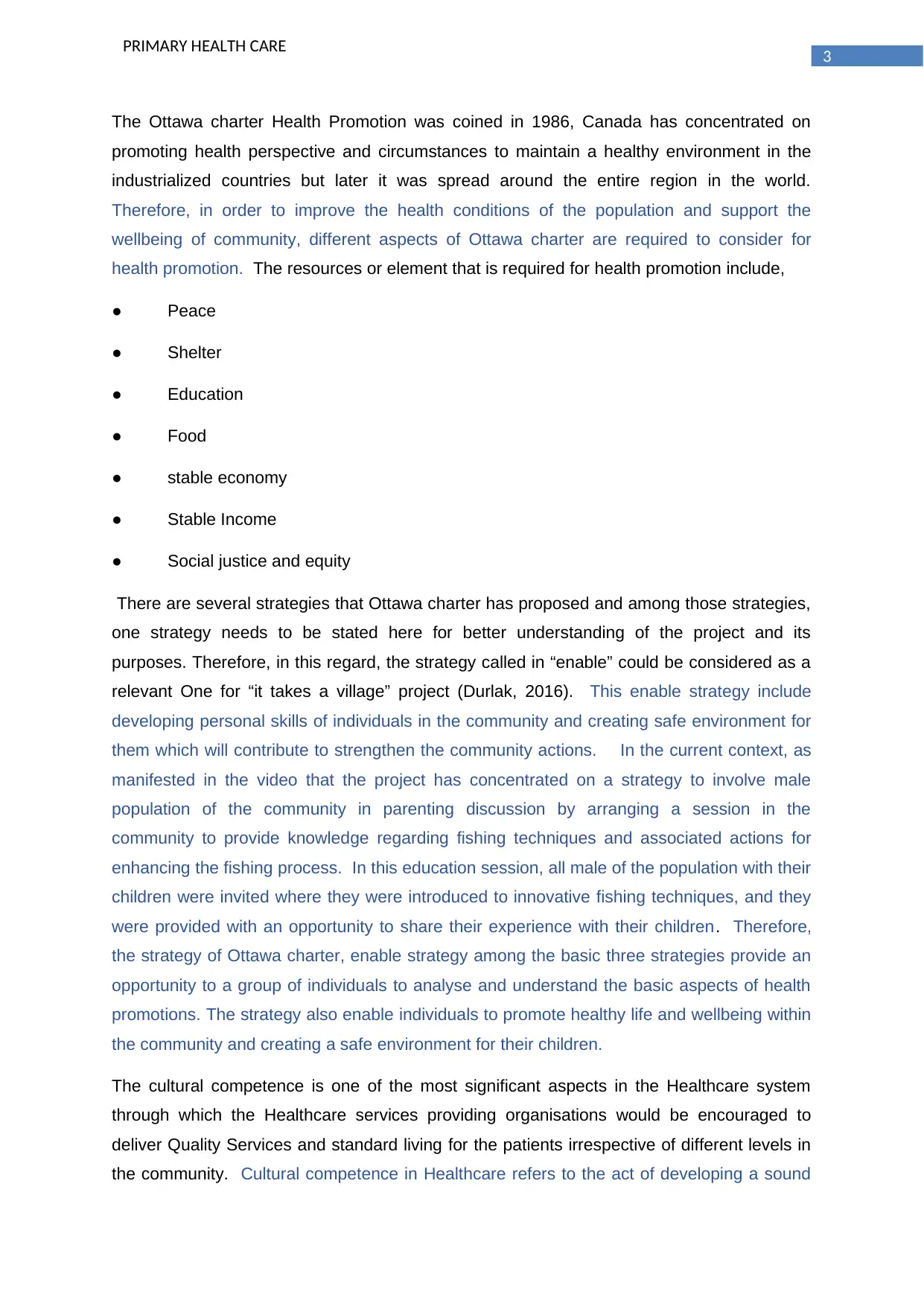
3
PRIMARY HEALTH CARE
The Ottawa charter Health Promotion was coined in 1986, Canada has concentrated on
promoting health perspective and circumstances to maintain a healthy environment in the
industrialized countries but later it was spread around the entire region in the world.
Therefore, in order to improve the health conditions of the population and support the
wellbeing of community, different aspects of Ottawa charter are required to consider for
health promotion. The resources or element that is required for health promotion include,
● Peace
● Shelter
● Education
● Food
● stable economy
● Stable Income
● Social justice and equity
There are several strategies that Ottawa charter has proposed and among those strategies,
one strategy needs to be stated here for better understanding of the project and its
purposes. Therefore, in this regard, the strategy called in “enable” could be considered as a
relevant One for “it takes a village” project (Durlak, 2016). This enable strategy include
developing personal skills of individuals in the community and creating safe environment for
them which will contribute to strengthen the community actions. In the current context, as
manifested in the video that the project has concentrated on a strategy to involve male
population of the community in parenting discussion by arranging a session in the
community to provide knowledge regarding fishing techniques and associated actions for
enhancing the fishing process. In this education session, all male of the population with their
children were invited where they were introduced to innovative fishing techniques, and they
were provided with an opportunity to share their experience with their children. Therefore,
the strategy of Ottawa charter, enable strategy among the basic three strategies provide an
opportunity to a group of individuals to analyse and understand the basic aspects of health
promotions. The strategy also enable individuals to promote healthy life and wellbeing within
the community and creating a safe environment for their children.
The cultural competence is one of the most significant aspects in the Healthcare system
through which the Healthcare services providing organisations would be encouraged to
deliver Quality Services and standard living for the patients irrespective of different levels in
the community. Cultural competence in Healthcare refers to the act of developing a sound
PRIMARY HEALTH CARE
The Ottawa charter Health Promotion was coined in 1986, Canada has concentrated on
promoting health perspective and circumstances to maintain a healthy environment in the
industrialized countries but later it was spread around the entire region in the world.
Therefore, in order to improve the health conditions of the population and support the
wellbeing of community, different aspects of Ottawa charter are required to consider for
health promotion. The resources or element that is required for health promotion include,
● Peace
● Shelter
● Education
● Food
● stable economy
● Stable Income
● Social justice and equity
There are several strategies that Ottawa charter has proposed and among those strategies,
one strategy needs to be stated here for better understanding of the project and its
purposes. Therefore, in this regard, the strategy called in “enable” could be considered as a
relevant One for “it takes a village” project (Durlak, 2016). This enable strategy include
developing personal skills of individuals in the community and creating safe environment for
them which will contribute to strengthen the community actions. In the current context, as
manifested in the video that the project has concentrated on a strategy to involve male
population of the community in parenting discussion by arranging a session in the
community to provide knowledge regarding fishing techniques and associated actions for
enhancing the fishing process. In this education session, all male of the population with their
children were invited where they were introduced to innovative fishing techniques, and they
were provided with an opportunity to share their experience with their children. Therefore,
the strategy of Ottawa charter, enable strategy among the basic three strategies provide an
opportunity to a group of individuals to analyse and understand the basic aspects of health
promotions. The strategy also enable individuals to promote healthy life and wellbeing within
the community and creating a safe environment for their children.
The cultural competence is one of the most significant aspects in the Healthcare system
through which the Healthcare services providing organisations would be encouraged to
deliver Quality Services and standard living for the patients irrespective of different levels in
the community. Cultural competence in Healthcare refers to the act of developing a sound
Paraphrase This Document
Need a fresh take? Get an instant paraphrase of this document with our AI Paraphraser
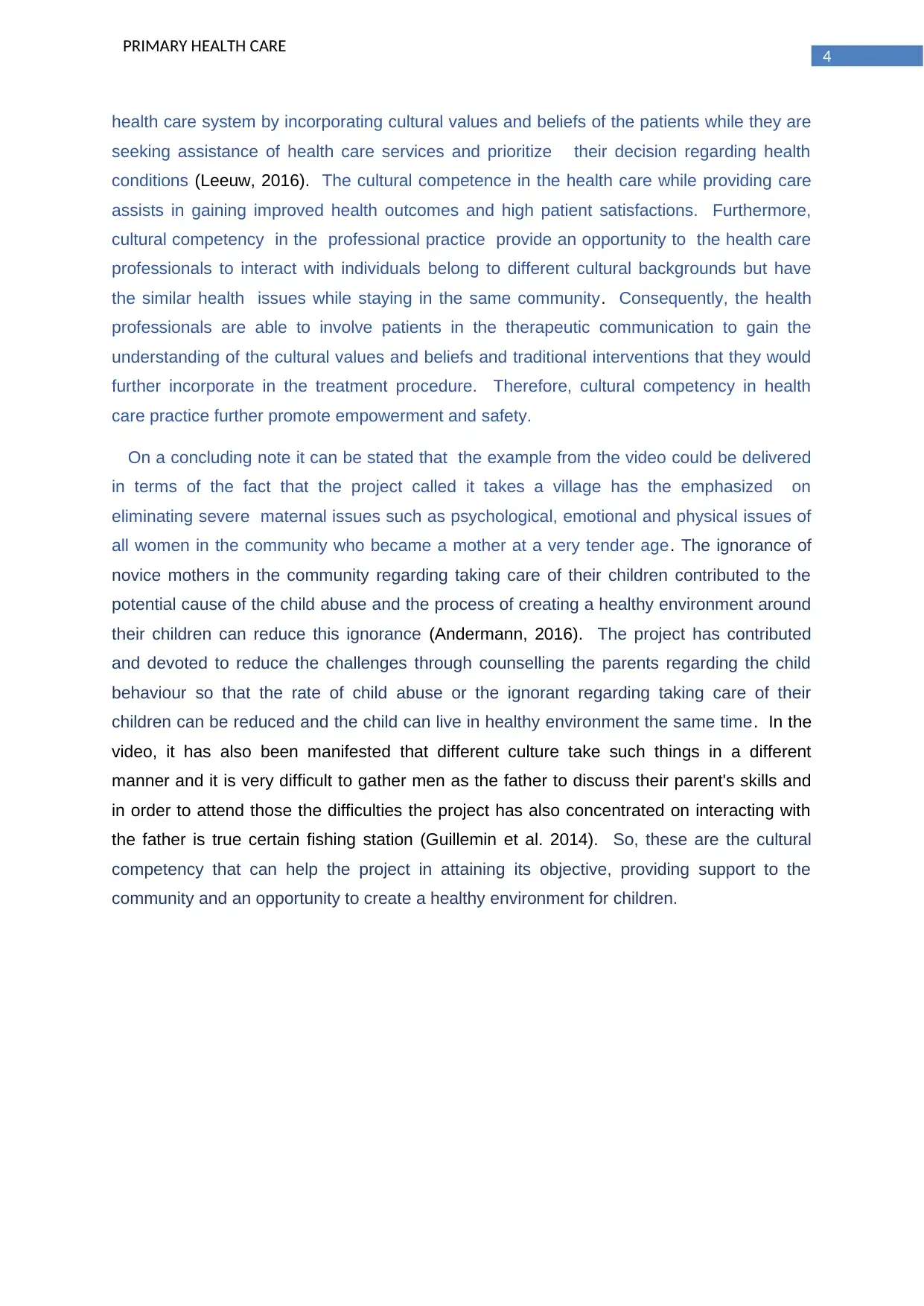
4
PRIMARY HEALTH CARE
health care system by incorporating cultural values and beliefs of the patients while they are
seeking assistance of health care services and prioritize their decision regarding health
conditions (Leeuw, 2016). The cultural competence in the health care while providing care
assists in gaining improved health outcomes and high patient satisfactions. Furthermore,
cultural competency in the professional practice provide an opportunity to the health care
professionals to interact with individuals belong to different cultural backgrounds but have
the similar health issues while staying in the same community. Consequently, the health
professionals are able to involve patients in the therapeutic communication to gain the
understanding of the cultural values and beliefs and traditional interventions that they would
further incorporate in the treatment procedure. Therefore, cultural competency in health
care practice further promote empowerment and safety.
On a concluding note it can be stated that the example from the video could be delivered
in terms of the fact that the project called it takes a village has the emphasized on
eliminating severe maternal issues such as psychological, emotional and physical issues of
all women in the community who became a mother at a very tender age. The ignorance of
novice mothers in the community regarding taking care of their children contributed to the
potential cause of the child abuse and the process of creating a healthy environment around
their children can reduce this ignorance (Andermann, 2016). The project has contributed
and devoted to reduce the challenges through counselling the parents regarding the child
behaviour so that the rate of child abuse or the ignorant regarding taking care of their
children can be reduced and the child can live in healthy environment the same time. In the
video, it has also been manifested that different culture take such things in a different
manner and it is very difficult to gather men as the father to discuss their parent's skills and
in order to attend those the difficulties the project has also concentrated on interacting with
the father is true certain fishing station (Guillemin et al. 2014). So, these are the cultural
competency that can help the project in attaining its objective, providing support to the
community and an opportunity to create a healthy environment for children.
PRIMARY HEALTH CARE
health care system by incorporating cultural values and beliefs of the patients while they are
seeking assistance of health care services and prioritize their decision regarding health
conditions (Leeuw, 2016). The cultural competence in the health care while providing care
assists in gaining improved health outcomes and high patient satisfactions. Furthermore,
cultural competency in the professional practice provide an opportunity to the health care
professionals to interact with individuals belong to different cultural backgrounds but have
the similar health issues while staying in the same community. Consequently, the health
professionals are able to involve patients in the therapeutic communication to gain the
understanding of the cultural values and beliefs and traditional interventions that they would
further incorporate in the treatment procedure. Therefore, cultural competency in health
care practice further promote empowerment and safety.
On a concluding note it can be stated that the example from the video could be delivered
in terms of the fact that the project called it takes a village has the emphasized on
eliminating severe maternal issues such as psychological, emotional and physical issues of
all women in the community who became a mother at a very tender age. The ignorance of
novice mothers in the community regarding taking care of their children contributed to the
potential cause of the child abuse and the process of creating a healthy environment around
their children can reduce this ignorance (Andermann, 2016). The project has contributed
and devoted to reduce the challenges through counselling the parents regarding the child
behaviour so that the rate of child abuse or the ignorant regarding taking care of their
children can be reduced and the child can live in healthy environment the same time. In the
video, it has also been manifested that different culture take such things in a different
manner and it is very difficult to gather men as the father to discuss their parent's skills and
in order to attend those the difficulties the project has also concentrated on interacting with
the father is true certain fishing station (Guillemin et al. 2014). So, these are the cultural
competency that can help the project in attaining its objective, providing support to the
community and an opportunity to create a healthy environment for children.
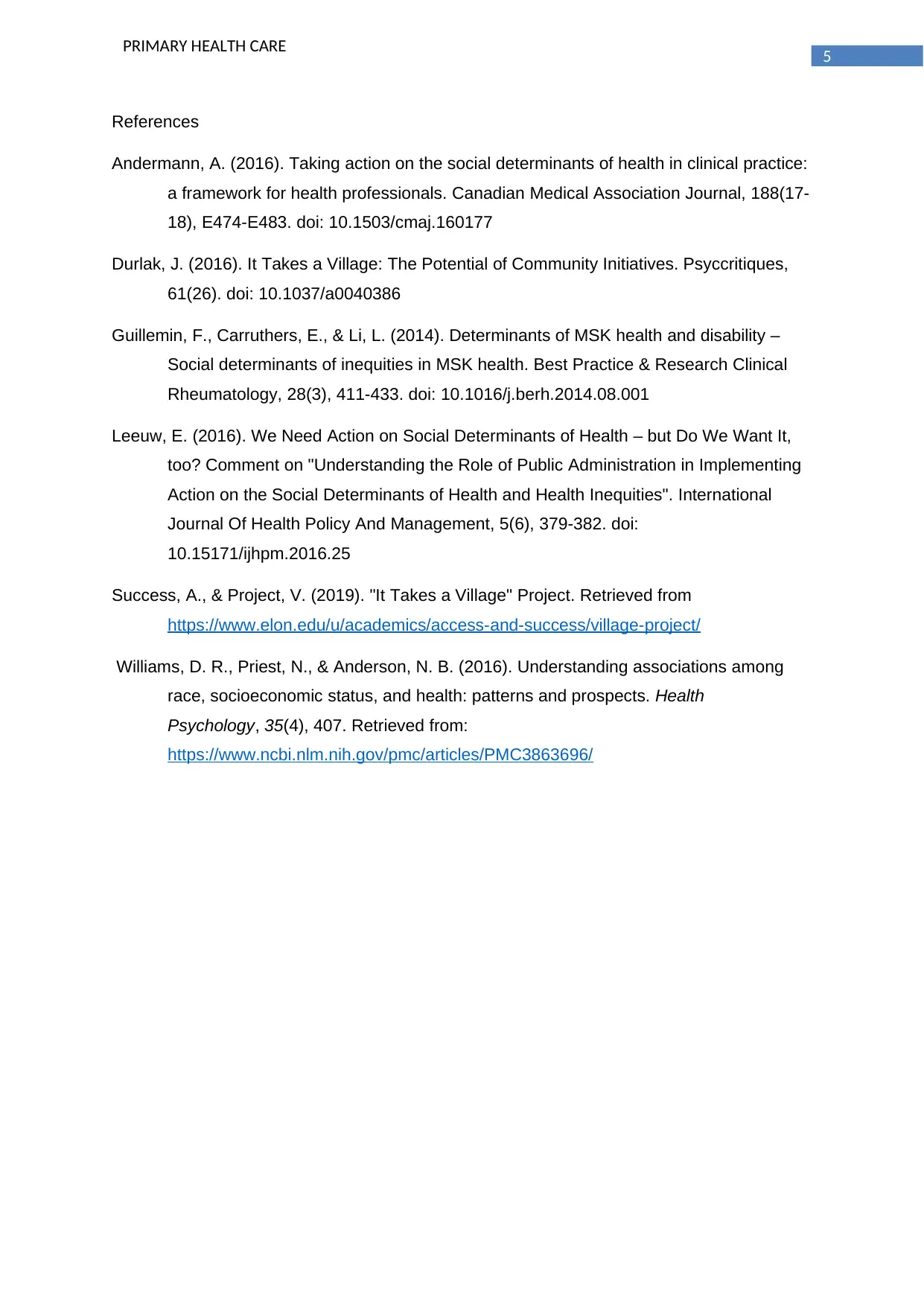
5
PRIMARY HEALTH CARE
References
Andermann, A. (2016). Taking action on the social determinants of health in clinical practice:
a framework for health professionals. Canadian Medical Association Journal, 188(17-
18), E474-E483. doi: 10.1503/cmaj.160177
Durlak, J. (2016). It Takes a Village: The Potential of Community Initiatives. Psyccritiques,
61(26). doi: 10.1037/a0040386
Guillemin, F., Carruthers, E., & Li, L. (2014). Determinants of MSK health and disability –
Social determinants of inequities in MSK health. Best Practice & Research Clinical
Rheumatology, 28(3), 411-433. doi: 10.1016/j.berh.2014.08.001
Leeuw, E. (2016). We Need Action on Social Determinants of Health – but Do We Want It,
too? Comment on "Understanding the Role of Public Administration in Implementing
Action on the Social Determinants of Health and Health Inequities". International
Journal Of Health Policy And Management, 5(6), 379-382. doi:
10.15171/ijhpm.2016.25
Success, A., & Project, V. (2019). "It Takes a Village" Project. Retrieved from
https://www.elon.edu/u/academics/access-and-success/village-project/
Williams, D. R., Priest, N., & Anderson, N. B. (2016). Understanding associations among
race, socioeconomic status, and health: patterns and prospects. Health
Psychology, 35(4), 407. Retrieved from:
https://www.ncbi.nlm.nih.gov/pmc/articles/PMC3863696/
PRIMARY HEALTH CARE
References
Andermann, A. (2016). Taking action on the social determinants of health in clinical practice:
a framework for health professionals. Canadian Medical Association Journal, 188(17-
18), E474-E483. doi: 10.1503/cmaj.160177
Durlak, J. (2016). It Takes a Village: The Potential of Community Initiatives. Psyccritiques,
61(26). doi: 10.1037/a0040386
Guillemin, F., Carruthers, E., & Li, L. (2014). Determinants of MSK health and disability –
Social determinants of inequities in MSK health. Best Practice & Research Clinical
Rheumatology, 28(3), 411-433. doi: 10.1016/j.berh.2014.08.001
Leeuw, E. (2016). We Need Action on Social Determinants of Health – but Do We Want It,
too? Comment on "Understanding the Role of Public Administration in Implementing
Action on the Social Determinants of Health and Health Inequities". International
Journal Of Health Policy And Management, 5(6), 379-382. doi:
10.15171/ijhpm.2016.25
Success, A., & Project, V. (2019). "It Takes a Village" Project. Retrieved from
https://www.elon.edu/u/academics/access-and-success/village-project/
Williams, D. R., Priest, N., & Anderson, N. B. (2016). Understanding associations among
race, socioeconomic status, and health: patterns and prospects. Health
Psychology, 35(4), 407. Retrieved from:
https://www.ncbi.nlm.nih.gov/pmc/articles/PMC3863696/
⊘ This is a preview!⊘
Do you want full access?
Subscribe today to unlock all pages.

Trusted by 1+ million students worldwide
1 out of 6
Related Documents
Your All-in-One AI-Powered Toolkit for Academic Success.
+13062052269
info@desklib.com
Available 24*7 on WhatsApp / Email
![[object Object]](/_next/static/media/star-bottom.7253800d.svg)
Unlock your academic potential
Copyright © 2020–2025 A2Z Services. All Rights Reserved. Developed and managed by ZUCOL.





